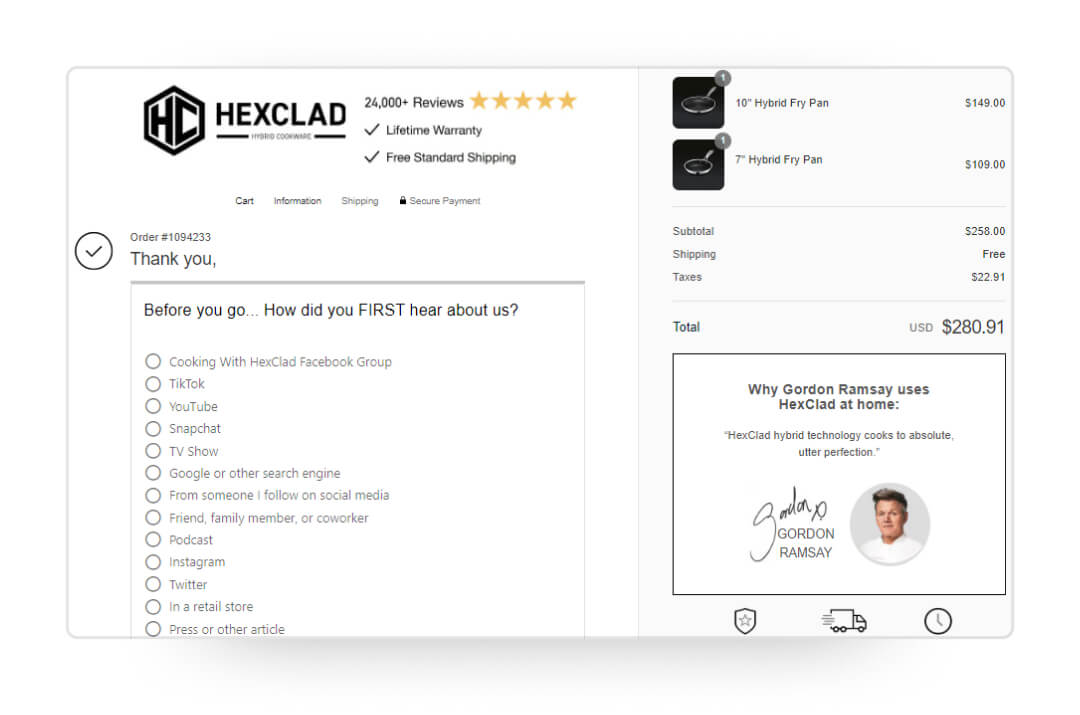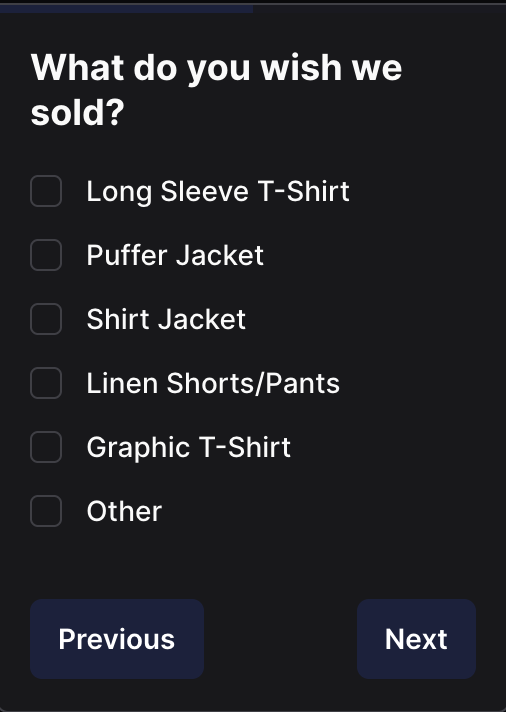
Most brands ask customers for feedback but never stop to think about the type of question they’re asking. Close-ended questions—like multiple choice or yes/no—are what turn customer feedback into data you can actually act on.
They’re fast, consistent, and scalable. And when you combine them with open-ended questions, you start to see not just what customers do, but why they do it.
Let’s break down what close-ended survey questions are, how to use them, and why the right mix can transform your post-purchase insights.
What is a close-ended question?
A close-ended question limits potential responses to a pre-determined list of options. Think multiple choice survey questions, yes/no responses, or rating scales.
They’re often used to collect quantitative data—numbers you can measure, compare, and benchmark over time. Perfect for brands who want clean data from a large sample size.
Close-ended vs. open-ended questions
In a post-purchase survey, you’ll find two types of questions: close-ended and open-ended. Each serves a unique purpose—and the best surveys use both.
Close-ended questions limit answers to a predefined list. They’re perfect for collecting consistent, quantitative data from large audiences. Think yes/no questions, multiple choice, or rating scales.
Open-ended questions go deeper. They usually start with “why,” “how,” or “what” and invite customers to share context in their own words—like why they bought, what influenced them, or how they felt about the experience.
One type isn’t better than the other. In fact, when designed effectively, they complement each other. A multiple-choice question can identify a friction point, while an open-ended one uncovers the story behind it.
Here’s how they can work together:
Close-ended: Did you find what you were looking for? [Yes or No]
Open-ended follow-up: If not, what were you hoping to find?
Close-ended questions
- Yield one-word or short responses like “Yes,” “No,” or a list selection
- Collect quantitative data
- Include multiple-choice, yes/no, or rating scale formats
- Are quick and easy for respondents to answer
Open-ended questions
- Often begin with “Why,” “How,” or “What”
- Collect qualitative data
- Allow respondents to express opinions, thoughts, and feelings in their own words
- Require more effort and time to answer—but provide deeper insights
Most survey questions can be written as either close-ended or open-ended, depending on how much detail you want to collect. If your goal is to benchmark or compare, go close-ended. If your goal is to uncover motivations or emotions, go open-ended.
Post-purchase survey questions can be framed as either open-ended or close-ended, depending on the level of detail desired.
Here are examples of similar questions in both formats:
| Close-ended question examples | Open-ended question examples |
| Would you recommend our product? | What were the main reasons you chose our product? |
| Did you have a good experience with us? | How would you describe your experience with us? |
| Would you buy another product from us in the future? | What would make you buy another product from us in the future? |
| Did you like our product? | What is the most important feature of our product to you? |
| Did you learn about our product/brand on Google? | What would you Google to find a business like ours? |
Why ask close-ended questions in your surveys?
If most questions can be asked either way, you may be asking yourself, “Why do I need both close-ended and open-ended questions?” Because there is a time and place for each.
Open-ended questions are great with smaller sample sizes for deeper insights. For instance, you may ask your top 1% of loyal customers for insights to inform your next product launch.
Close-ended questions have their own benefits for ecommerce brands:
- Higher response rates: Checking a box is obviously easier than typing a response. They’re great for large sample sizes or automated workflows like post-purchase customer experience surveys.
One study found that close-ended questions yielded a 67% completion rate while open-ended questions came in at 44.7%. - Consistent data: Enables easy comparison across time periods or audience segments.
- Scalable insights for benchmarking: Ideal for spotting trends and tracking KPIs like NPS, CSAT, or product ratings over time.
- Segmentation opportunities: Classify customers by behavior, satisfaction, or preferences. For example, if you ask audience-based questions in PPS like what product collections they’re interested in, you can target your communications based on their interests.
Types of close-ended survey questions (and when to use them)
There are many different types of close-ended survey questions you can ask in pre-purchase, abandoned cart, or post-purchase surveys. Each one is beneficial for different use cases.
Dichotomous questions
These are close-ended questions that only have two response options, like “yes or no”, “true or false”, or “agree or disagree”.
When to use: To quickly validate key customer behaviors or satisfaction metrics in post-purchase or NPS surveys.
Examples:
- Were you satisfied with your order delivery?
- Would you recommend this product to a friend?
A simple yes or no question uncovered an entire untapped target market for SwimOutlet.

“Before Kno, the brand assumed that the majority of their customers—around 80%—were part of swim teams. However, the data told a different story. In reality, only 51% of their customers were affiliated with swim teams, while the other half represented a much broader audience, from recreational swimmers to those who simply loved being in the water.”
As a result, they changed their marketing and targeting approach to capture a broader audience and increase their target audience.
Multiple choice
These are questions where respondents can choose one option from several predefined options.
When to use:
Marketing attribution, purchasing motivations, or product preferences.
Segmentation: Classify responses for retargeting or email personalization.
Examples:
Where did you first hear about us? Choices: Instagram, Google, Friend, Podcast, etc…
What best describes your reason for purchasing today? Choices: Gift, Personal use, Replacement, Curiosity, etc…
HexClad’s post-purchase attribution survey captures buyers’ attention right on the order confirmation page. This validated podcast and Snapchat ad performance and helped them narrow down their media spend to targeted shows accordingly.

Rating scale
Questions that measure satisfaction or intensity on a numeric or star-based scale, typically 1-5.
When to use: Quantifying customer satisfaction with products, delivery, or the overall customer experience. Using a numerical scale gives you a benchmark that you can measure over time to track performance.
Examples:
How would you rate your checkout experience? (1–5 stars)
On a scale of 1–5, how likely are you to shop with us again?
Likert scale
Questions that gauge agreement or disagreement with statements about the brand, products, or experience.
When to use: To understand perceptions of brand trust, product quality, or website UX
Examples:
I found it easy to navigate the website. Scale: Strongly disagree → Strongly agree
The product matched its description on the website. Scale: Strongly disagree → Strongly agree
Ranking
Questions that ask respondents to order items by preference or importance.
When to use: Great for research and development to prioritize new product ideas, features, marketing messages, or value propositions. You can also use these to validate a hypothesis with your target market or track customer preferences and usage habits quantitatively
Examples:
Rank what’s most important when buying clothing from us: Price, Quality, Style, Fit, Color, etc…
Rank the following upcoming product categories you’d be most excited about: Joggers, Swim Trunks, Polos, etc…
Checkboxes
Similar to multiple choice, these are questions that allow respondents to select multiple answers from a list. These often have a disclaimer that says, “Check all that apply.”
When to use: When customers may have multiple reasons for purchasing, browsing behaviors, or brand touchpoints. These are also great for early-stage feedback collection to gauge interest or identify major blockers quickly.
Examples:
What influenced your decision to buy today? Options: Sale, Reviews, Social Media Ad, Free Shipping
Which categories apply to you? Options: First-time shopper, Returning customer, Gift buyer, Subscriber, etc…
When Birddogs asked customers what product they wanted next, the responses confirmed excitement for something already in development—a lightweight sweater.
Using that data, the team segmented their audience and sent a targeted email to everyone who had expressed interest.
The subject line? “You asked for this — and we made it for you.”

And the result was rewarding for both Birddogs and their customers, as shoppers felt genuinely heard, which led to an engagement spike and sales that outperformed projections.
6 close-ended question examples for ecommerce surveys
Close-ended questions give you quantifiable data that’s easy to analyze, segment, and act on. The best surveys use a mix of both open and close-ended questions, but when you want clarity at scale, these are your go-to.
Here are examples grouped by goal so you can choose the right questions for your next post-purchase survey.
Attribution and marketing
These questions reveal how customers discovered you and what influences their buying decisions — essential for optimizing ad spend and partnerships.
- Where did you first hear about us?
Multiple choice: Ads, social media, word of mouth, Google, email, etc. - Did you notice our brand partnership with [brand/influencer/media]?
Yes / No - Do you usually wait for a sale before purchasing on our site?
Yes / No
Audience building
Find out what your customers care about most so you can tailor campaigns, segment audiences, and refine your brand voice.
- What do you consider most important when choosing to shop with a brand?
Multiple choice: Quality, price point, brand values, sustainability, etc. - Is this a gift?
Yes / No - Rank your favorite types of workouts.
Ranking: Cardio, aerobic, strength, pilates, swimming, etc.
Customer experience
These questions pinpoint friction points in your site experience — the kind that directly impact conversions.
- Was it easy to find what you were looking for?
Yes / No - Did you encounter any issues checking out?
Yes / No - On a scale of 1–10, how likely are you to recommend us?
- How valuable would it be if you could have called us before your purchase?
Scale: 1 = not valuable → 5 = extremely valuable
Customer lifetime value and retention
Measure loyalty and purchase intent to forecast repeat behavior and test incentives.
- How likely are you to purchase from us again in the future?
Scale: 1 = not likely → 5 = extremely likely - Have you purchased from us before?
Yes / No - Which three factors would most influence your next purchase?
Checkbox: Limited editions, discounts, restocks, etc.
Pricing
Gauge perception of value and surface opportunities to improve pricing strategy or transparency.
- Is our pricing too high, too low, or just right?
Multiple choice: Too high / Just right / Too low - Were there any hidden fees or unexpected charges during checkout?
Yes / No
Product development
Use these to validate roadmap decisions and prioritize the product features your customers truly care about.
- Did the product
meet your expectations?
Yes / No - Rank what features are most important when shopping for products like ours.
Ranking: Sizing, colors, packaging, price, materials, etc. - Is quality or price more important to you?
Either / Or: Quality / Price
Tips for asking close-ended questions that get answered
Creating strong close-ended questions is about clarity, context, and keeping your customers engaged enough to finish. Here’s how to do it right with effective close-ended questions that will ensure you can increase your response rates.
- Keep it clear and focused – Ask one thing at a time. The more specific the question, the cleaner your data will be. For example, instead of mixing topics, ask one question about the checkout experience and another about delivery.
- Cover all possible answers – Always give respondents room to answer honestly. Adding an “Other” or “Prefer not to say” option prevents survey fatigue and keeps response rates high.
- Avoid leading questions – Neutral wording helps you get genuine feedback. Instead of asking “How much did you love our shipping?” try “How would you rate your shipping experience?” Small shifts like that make your data more reliable.
- Balance your scales – If you’re using ratings, keep them consistent. Scales like 1–5 or 1–10 make it easier to track changes over time and compare results across products or campaigns.
- Test before you launch – Run a small test survey in KnoCommerce or use the survey preview feature to check that your questions make sense and that your answer options feel balanced. A quick test can catch confusion before it impacts your results.
Kno makes it easy to build your survey from scratch or launch in minutes with pre-built templates.
Turn close-ended questions into customer insights with KnoCommerce
Close-ended questions give you customer data that’s easy to analyze and act on. They help you track trends, benchmark success, and segment audiences in ways that lead to smarter marketing decisions.
When analyzing your quantitative survey data, look for trends, averages, and standout patterns to understand what’s working and what’s not. For example, your attribution survey might reveal whether you’re over- or under-investing in certain acquisition channels, helping you refine spend and strategy across campaigns.
KnoCommerce makes this process simple by automating data collection and analysis for both close- and open-ended questions, then layers in filtering, segmentation and reporting to surface insights faster. It also connects seamlessly with ecommerce tools like Shopify, Klaviyo, and Zapier so you can turn those insights into real-time marketing actions, such as personalized emails or SMS campaigns.
Want to see how leading brands are using close-ended survey questions to uncover trends, benchmark performance, and drive growth? Explore our post-purchase survey questions or book a demo to see how KnoCommerce turns quick responses into powerful business insights.